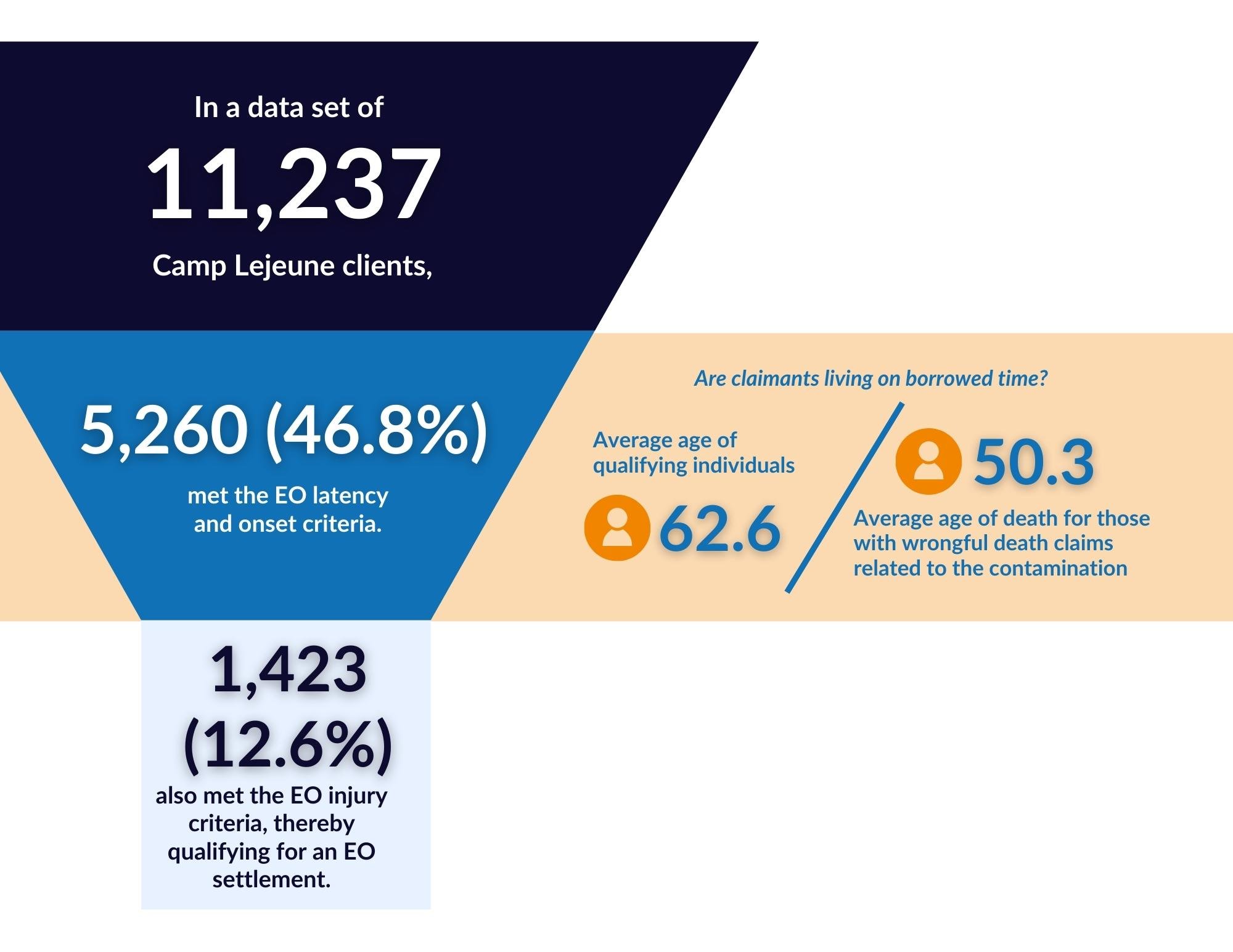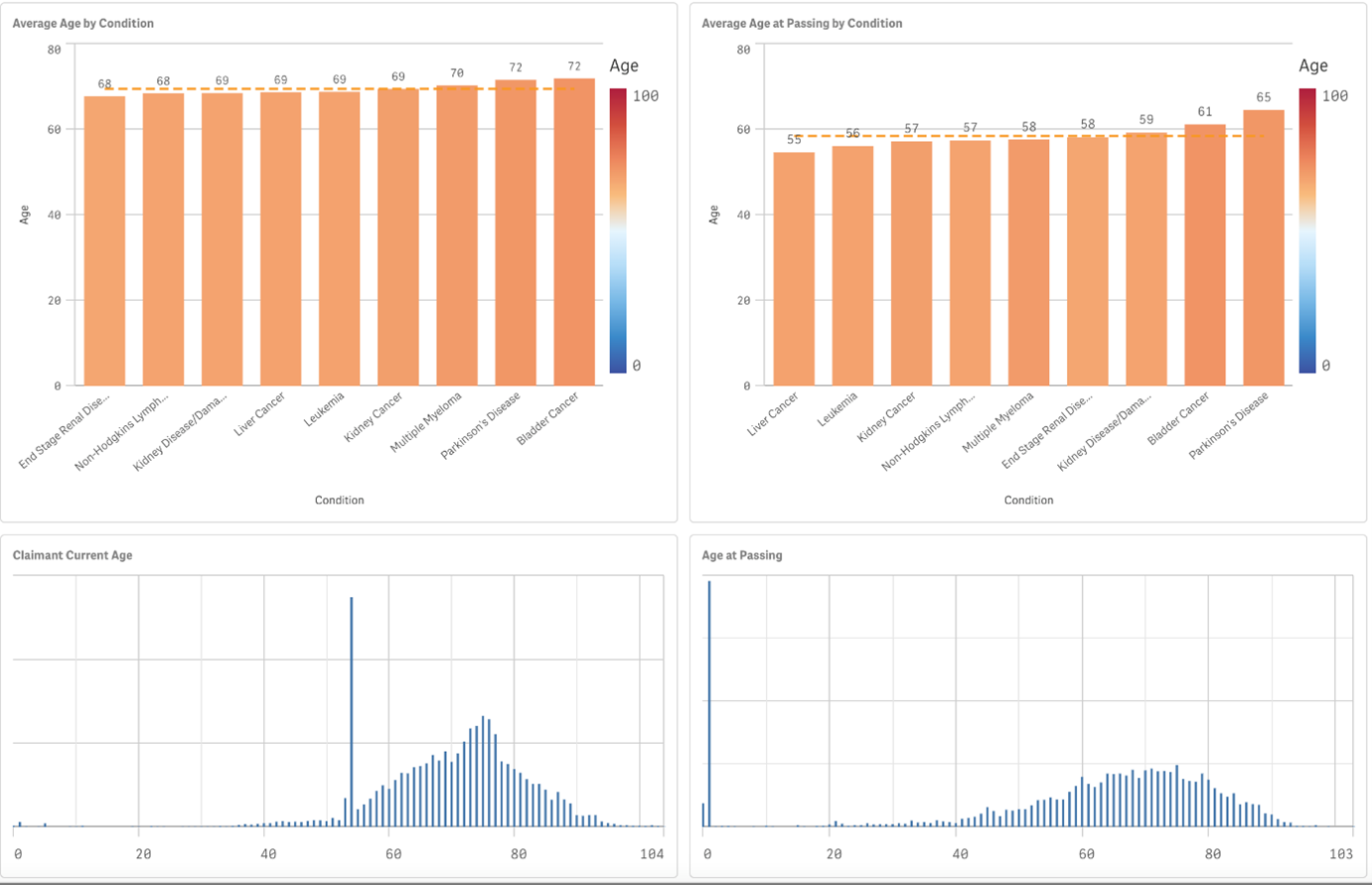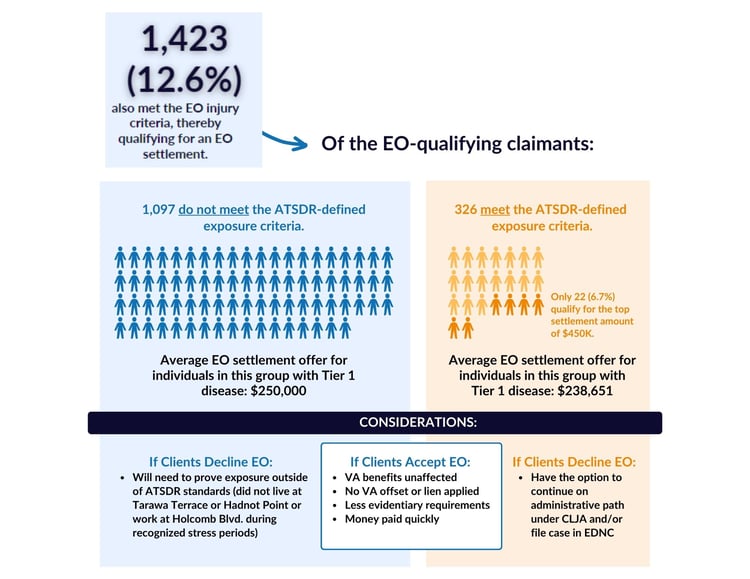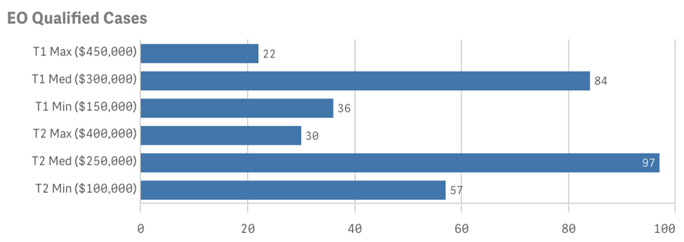Camp Lejeune Litigation: Understanding the Elective Option
Jessie Hoerman
Sep 21, 2023

Mass Torts 360 Overview

Camp Lejeune

Boy Scouts of America

Mass Torts 360 Overview

Camp Lejeune

Boy Scouts of America


SimplyConvert analyzed a pool of just over 11,000 Camp Lejeune claimants in our Mass Torts 360™ platform to understand the impact of the recently-released Elective Option for Camp Lejeune Justice Act Claims (hereafter “EO”). We found that 46.8% of claimants passed the onset1 and latency2 test, and 12.6% also had a qualifying injury as defined by the EO3.
The average age of claimants with a qualifying injury under the EO is currently 62.6 years old. SimplyConvert has found that the average age of death in lawsuits brought by representatives for claimants who had the qualifying diseases before death is 50.3 years old. While each case is different, and advances in medicine in 2023 allow even those diagnosed with terminal illnesses to live longer lives, it is important to understand that for every qualifying EO condition, claimants are outliving those before them.

The chart below breaks out the average age by condition and the average age at passing under wrongful death claims for EO-qualifying injuries.

SimplyConvert wanted to understand the reason so many clients failed to qualify for the EO. For the majority, it appears that their diagnosis/first treatment happened outside of the 35-year latency requirement (this includes 70% of those that failed in our pool). The secondary reason is that they do not meet the 2-year requirement under the latency test. A very small percentage of those who fail do not meet the onset requirement of a diagnosis or treatment by December 10, 2022 (4%). It is unclear where the DOJ's 35-year latency rule originated, but it has definitely decreased the number of claimants who can consider the EO program.

The EO program is not likely to make much of a dent in fast-tracking the more than 93,000 claims that are currently filed with the Navy, despite their statement noting their commitment “to ensuring that every valid Camp Lejuene claim is resolved fairly and as expeditiously as possible.”
Many of the very sick individuals will need to consider a settlement of any amount since they won’t have the time to continue through the administrative program. But SimplyConvert’s database shows that 23% of the individuals who qualify under the EO also qualify under ATSDR standards and already had an expectation of an easier evidentiary standard for exposure. These “dual qualified” individuals can show that they lived at either Tarawa Terrace or Hadnot Point (or worked on Holcomb Blvd.) during the specified “stress periods” and were diagnosed with an ATSDR- presumptive disease.
Dual-qualified claimants will have the choice to take the EO settlement or continue down the administrative path provided under the Camp Lejeune Justice Act. Within the pool analyzed by SimplyConvert, we found that only 6.7% of dual-qualified claimants can expect the top settlement offer of $450,000 under the EO program. The average settlement offer of the remaining dual-qualified claimants in our pool is $238,651, as broken out in the detailed graph below.

 The non-dual qualified claimants (1,097 in our pool) are in a different position, and lawyers representing them will need to talk through their individual positions on a case-by-case basis. It is likely these individuals have a longer road ahead of them since they will need to prove exposure outside of ATSDR standards (they did not live at Tarawa Terrace or Hadnot Point or work at Holcomb Blvd. during the specified stress periods). The average offer is just above $250,000 for a Tier 1 disease. But, they will need to consider the benefit of no VA benefit, less evidentiary requirements, and the time value of money. It is likely there will be a decent percentage of individuals in this group that will opt into the EO.
The non-dual qualified claimants (1,097 in our pool) are in a different position, and lawyers representing them will need to talk through their individual positions on a case-by-case basis. It is likely these individuals have a longer road ahead of them since they will need to prove exposure outside of ATSDR standards (they did not live at Tarawa Terrace or Hadnot Point or work at Holcomb Blvd. during the specified stress periods). The average offer is just above $250,000 for a Tier 1 disease. But, they will need to consider the benefit of no VA benefit, less evidentiary requirements, and the time value of money. It is likely there will be a decent percentage of individuals in this group that will opt into the EO.
The EO is not a vehicle that will bring relief to a substantial amount of claimants. At best, we may see around 10% of the claimants take advantage of this quick pay option (1,097 out of the 11,000 in our pool).
Data is power and the more you know about each of your client's situations, the better you'll be able to advise on the best course of action. We developed Life at Lejeune™ to help your firm collect the data needed to help your clients make informed decisions. Life at Lejeune builds upon the data you've already gathered from your clients and further documents their specific exposure to the contaminated water, allowing you to build each case. Schedule time to meet with us to hear more about Life at Lejeune™ and download the full Elective Option Infographic below.
A note on the data: the data above comes from a randomized pool of approximately 11,000 Camp Lejeune claimants. This analysis is an estimate only and can’t be relied upon until all client data has been collected. SimplyConvert adjusts reports in real-time as more client data is collected and will continue to utilize the EO Optimizer to analyze the eligibility of claimants for DOJ’s EO program.
1The EO requires that all injuries must have been diagnosed or treated before August 10, 2022 (“onset test”).
2The EO requires the earliest date of diagnosis must not be less than two (2) years after the claimant’s first exposure and not greater than thirty-five (35) years after the claimant’s last exposure (“latency test”).
3Tier 1 qualifying injuries include Kidney Cancer, Liver Cancer, Non-Hodgkins Lymphoma, Leukemias, and Bladder Cancer. Tier 2 qualifying injuries include Multiple Myeloma, Parkinson's Disease, Kidney Disease/End Stage Renal Disease, and Systemic Sclerosis.